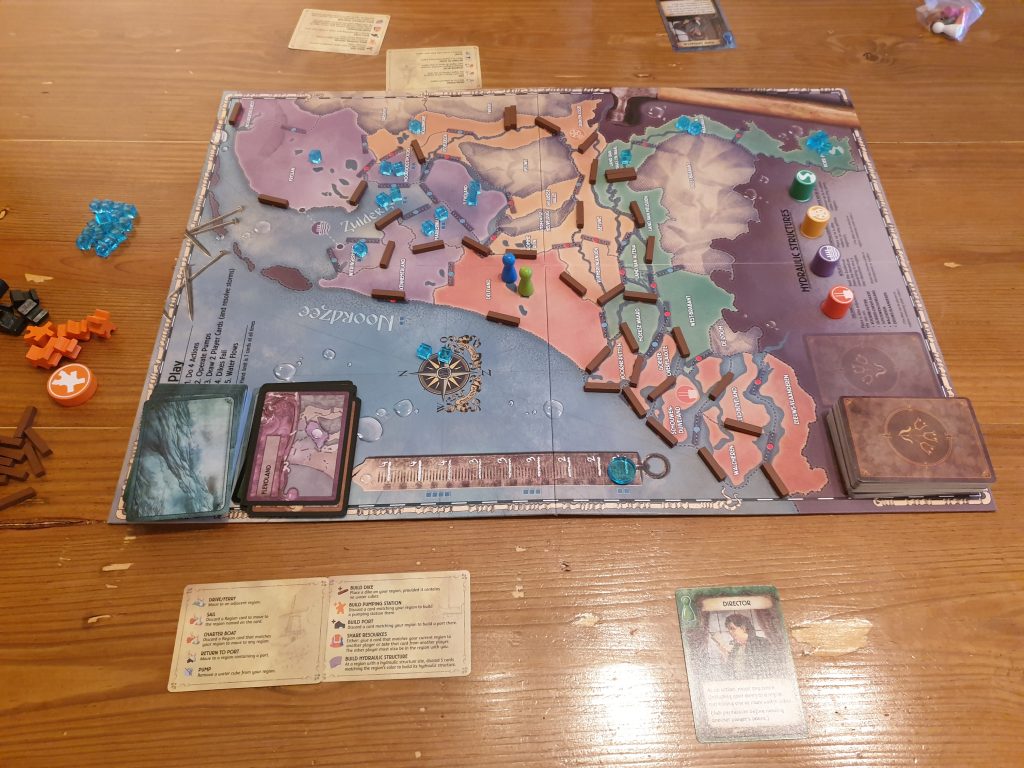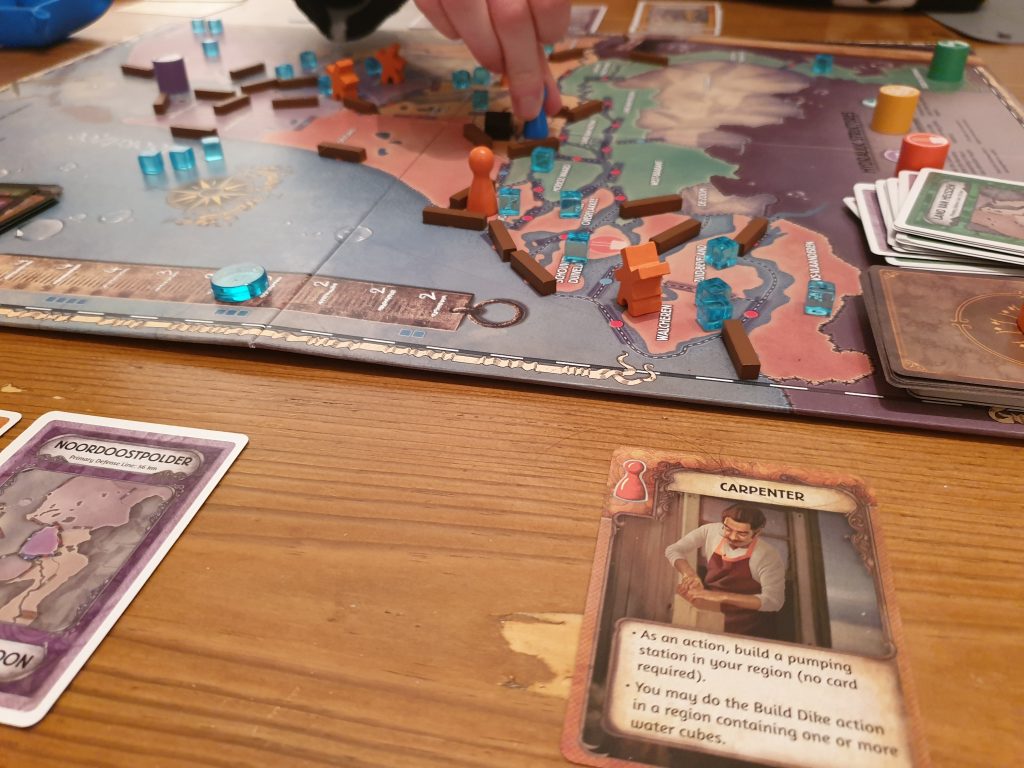Pandemic Rising Tide is the 2017, round the world like, variant of Matt Leacock’s iconic cooperative franchise. Co-designed by Jeroen Doumen, with Leacock, it is a board game with hints of hand management from publisher Z-Man Games, featuring art from Atha Kanaani. The game sees 2 – 5 players journey to the Netherlands, during the Industrial Age. Players are tasked with stopping the rising tide from flooding the country and building up the dykes and infrastructure. However, is this a title to rise the ranks or be carried out by the tide? Let’s find out!
Setup is similar but not the same as regular Pandemic; with characters chosen, decks shuffled, and general components placed within reach. The first change is a new component, with all 50 wooden dykes placed onto the indicated dyke zones on the map. Secondly, a selection of regions – the replacement for cities – start with water cubes before the dyke failure deck is initially touched.
As with the original’s infection cards, 3 dyke failure cards are turned over and the indicated regions are impacted 3 times Next, 3 more dyke failure cards are flipped, which are impacted twice. 3 final cards flipped and impacted once. In Rising Tide it isn’t simply the case of adding cubes when turning over a location, instead it causes the region to be degraded. If it has one or more dykes one is removed. When a region has no dykes along its edges to degrade a water cube is added instead.
Once all the degrading has occurred it is time for the water to flow. A few of the Netherlands regions are classed as high elevation so are never impacted by water, the rest being low elevation regions and ready to be flooded. Any region which is connected to a region with water cubes, without a dyke placed between them, gets a total of 1 less water cube. For example, a region with 1 water cube adjacent to a region with 3 cubes, without a dyke, would be increased to 2 cubes instead of taking 2 cubes. If the dyke is built then water would not flow, so the region would have stayed at 1 cube in the above example. Note, there are two seas that start with two water cubes. Any region connected to the sea without a dyke is flooded from the sea.

The game is then ready to play. It sounds a lot but after a game this can be all done in a couple of minutes – shuffling and all. Throughout the game players will be performing 4 actions on their turn: before activating constructed pumps, drawing player cards, degrading locations and seeing the water flow. To combat the water flow as actions players can: move region, remove a single water cube from their region, build a dyke in a dry region, build a pumping station, build a port or build one of the four Hydraulic structures. Movement is limited to adjacent regions or ports, unless the player spends a player card of where they want to go or where they are located. It can be a long journey from one end of the country to the other, so this player card based boat chartering comes in handy.
Building the four Hydraulic structures is the aim of the game but they also give instant bonuses along the way, ranging from dykes along the seafront to a dam that allows entry into the previously flooded Zuiderzee region. Players must construct all four before either the player deck runs out of cards or the Netherlands becomes too waterlogged – when the water cubes run out. As a cooperative title the players around the table win or lose together no matter what happens.
Having two of each region shuffled into both the player and dyke failure decks may sound a small tweak but it means you can get very unlucky very quickly. Increasing the memory element of the dyke failure deck, you can be hit twice in a row by the same locations before having a chance to recover and rebuild. Whilst this luck aspect can be painful at times it instils a massive amount of tension into the game as no location is safe. In regular Pandemic there are times a location can be on 3 cubes but having already come up isn’t a priority. In Rising Tide a location with 2 cubes could still be a huge priority.
To elevate this tension the game can start with a lot of flooding from the very beginning. In most other variants only a smattering of cubes are used, often of different colours. In Rising Tide most of the cubes could start on the board after an agonising setup! The volume of water that can start on the board is only the first aspect that adds increased difficulty to the game, compared to the original. Players will also have to deal with an increased number of storm cards (epidemics), thankfully there isn’t an outbreak end game condition though.

Included in the box are a variety of ways to tweak the gameplay and make the game even more of a challenge. This isn’t just including an additional storm card. Population cubes along with a population loss mechanic can be added. Goal cards can also feature, with multiple for each colour region – though only one of each colour should be used simultaneously. I would advise not playing with any of the modules for a few games – as Rising Tide is harder than regular Pandemic. The fact that these extra experiences are already in the box waiting for your to stretch yourself after a few games though is brilliant, even if we have yet to win with any of them included!
Some of the role powers at first seem super strong. Being able to move any pawn to a location with water when half the board is flooded gives almost free movement anywhere. At the same time sponging up a water cube from an adjacent region should be epic. They are impactful in the early game but when the board truly is flooded one extra water cube is but a drop in the ocean. Rising Tide is certainly more difficult than the original and Iberia, potentially as it is a completely different puzzle to solve.
There is an increased amount of choices for players to make in Rising Tide, which makes this a brilliant step up for fans of the series. While ports seem underwhelming based upon the roles being used, where to build pump stations feels very meaningful. The only issue is that there isn’t a way to boil the game down to make it easier to introduce new players to. I’d certainly still start people off with the original or Iberia first over Rising Tide.
There is one threat to losing the game as sinister as the floods, the components. Put simply, don’t dare knock the board or the game can be unrecoverable. With up to 50 fiddly dyke cuboids and then water cubes across the board not only can it be awkward to move them around but also given their closeness they are easily knocked. The odd tap here and there is fixable but a severe knock to the table would result in either starting again or a memory game of what the board looked like.

The board itself looks visually nice, with the coloured regions helping players find locations easier. However, the design does little to make the board clearer to play on. Rivers snake across the board which reduces the readability of an already cluttered board, with them being easily confused with region borders.
For those that live in the Netherlands, or are knowledgeable to know its geography, the map may not be as much of an issue. For the rest of us, even after a few games, there are a lot of unusually named regions that are hard to locate. A problem only exacerbated with the similar names of regions like Noorderzijlvest and Noordoostpolder. While I prefer this to the regions being arbitrarily renamed it is akin to playing a Ticket to Ride map variant, where you don’t know the locations. The cards thankfully feature a location help but even with these it can take a few extra seconds to find the right region to degrade.
Losing the original Pandemic seemed to occasionally due to running out of time, effectively running out of cards in the player deck. This hasn’t been the case in Rising Tide with the cascading floods washing away our hopes each game. Despite being only one type of cube to rid the board of, the game retains the Pandemic feel, though players will have to change their previous strategies.
Part of the challenge is to not be sucked into the potentially calm water before the storm, wasting actions. Very quickly the water cubes can be flooding a quarter of the board. Another aspect is to quickly learn where regions are and how the water flows. For the gameplay challenge Rising Tide offers a strong coop experience. It is just a shame the first couple of games are marred by the board layout and, for most, a lack of Netherlands geography knowledge.
[Editor’s Note: Pandemic Rising Tide was provided to us by Asmodee for review purposes. The game is currently available on 365 Games for £34.19. It is also available from local UK board game stores, find your local store here]

